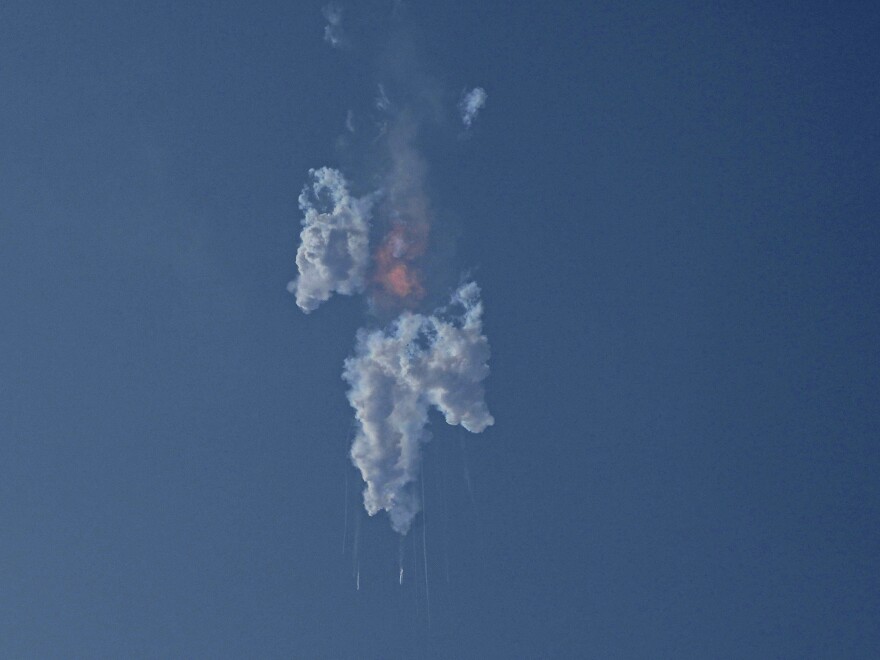Updated March 14, 2024 at 8:59 AM ET
The first time, it tumbled out of control and exploded; the second time, an onboard fire triggered its self-destruct mechanism.
Now, SpaceX will once again attempt to fly its giant rocket, Starship.
A 110-minute launch window opened at 8 a.m. ET. SpaceX is streaming the launch on its website and on the social media platform X. Launch is expected just before 9:30. The company said the chances of launch were 70%, though high-level winds could be a problem. You can follow along below.
Watch Starship's third flight test https://t.co/1u46r769Vp
— SpaceX (@SpaceX) March 5, 2024
It has promised "excitement guaranteed" at every stage of the flight.
The company has made upgrades and likely changed procedures since its previous attempts, but it remains to be seen whether this will be the launch that proves that the largest rocket ever built can really fly.
"They say that the third time is a charm," says Paulo Lozano, director of the space propulsion laboratory at MIT. But, he adds, launching a rocket as large as Starship "is not a simple task."
"Nobody has done like this before at this scale," he says.
Starship is a stainless steel monster. It stands nearly 400 feet tall, and its first stage, known as "Super Heavy," is powered by 33 Raptor engines that must all work together to heave it towards orbit.
SpaceX founder Elon Musk believes this massive machine can carry humans to the moon and Mars. Its durable stainless steel construction makes it easy to reuse, at least in theory, and could dramatically reduce the cost of launching satellites and people into orbit. NASA has given billions to SpaceX to develop Starship as a lunar landing system that could deliver astronauts to the lunar surface.

But before Starship can fulfill these lofty ambitions, it's got to fly. In its first test, nearly a year ago, the spacecraft made it off the ground, but it did considerable damage to the launch pad in the process, hurling concrete and debris for up to half-a-mile. Multiple engines in the first stage gave out, and as the rocket fell back to Earth, its self-destruct system also failed to properly destroy it. It tumbled out of control for several seconds before finally breaking apart.
The second flight in November was more successful. The launch pad was not obliterated by the 33 engines, all of which fired as expected. The Starship also successfully separated from its booster at the predetermined altitude. But the booster failed to reignite its engines properly and exploded before it could descend back to the Gulf of Mexico. Starship's self-destruct system (beefed up after the first flight) also detonated before it could reach its desired altitude.
Scott Manley, a popular YouTuber who closely tracks Starship launches, says that the second stage likely failed because it had too much fuel and oxidizer aboard. To try and reduce mass as it flew into space, "it began dumping excess oxygen," he says. Unfortunately, the oxygen, which is highly flammable, apparently caught fire either in or around the rear of the rocket. "There was a fire in there that got turbo-charged by having oxygen just leak all over it," he says.
This time around, Manley says several additional changes have been made. Based on photos taken by rocket-watchers near the site, the fire suppression system appears to have been beefed up and the oxygen-dumping system has also been tweaked. "That will probably solve that problem," he says, but adds, "It doesn't guarantee they've solved every single problem."
Starship has also added additional tasks to the flight test. It will attempt to briefly open its payload bay doors while in orbit. And it will conduct a test to see whether it can transfer propellant from one fuel tank to another. Moving fuel around will be critical for both lunar and Martian trips, as the vehicle will need to top off its tanks for both journeys.
Lozano says that fuel transfer is particularly challenging in space.
"All of these propellants have very high vapor pressure," he says. That means if they're exposed to the vacuum of space, they will "decompress explosively." Even the act of pumping fuel is tricky in zero gravity, Lozano, says, because there's no force pressing the fuel towards the bottom of the tanks, where pumps might normally operate.
"There is no experience doing this kind of thing," he says. "It's a new technology, but I'm pretty sure that technically it's possible to do."
Finally, Starship will also attempt to relight its Raptor engines before re-entering Earth's atmosphere. Both Manley and Lozano say they will be closely watching that process.
As Starship enters the atmosphere, "you need to protect it from massive amounts of heating," Manley says. The underbelly of the ship is covered in thermal protection tiles, he says, but "they've been falling off on every single test. So it remains to be seen whether they can actually keep enough tiles on Starship for it to make it through re-entry."
"If it comes back in one piece, I think it's going to be a big success," Lozano says.
In total, the flight test will take a little over an hour, and — assuming all goes well — the spaceship will splash down in the Indian Ocean.
Copyright 2024 NPR. To see more, visit https://www.npr.org.







